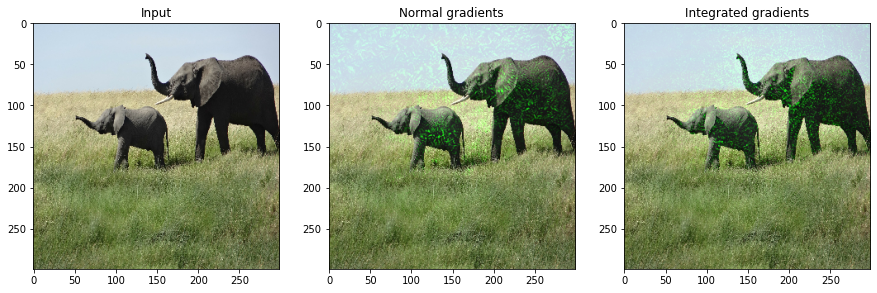Keras 2 : examples : 積分勾配によるモデル解釈 (翻訳/解説)
翻訳 : (株)クラスキャット セールスインフォメーション
作成日時 : 11/24/2021 (keras 2.7.0)
* 本ページは、Keras の以下のドキュメントを翻訳した上で適宜、補足説明したものです:
- Code examples : Computer Vision : Model interpretability with Integrated Gradients (Author: A_K_Nain)
* サンプルコードの動作確認はしておりますが、必要な場合には適宜、追加改変しています。
* ご自由にリンクを張って頂いてかまいませんが、sales-info@classcat.com までご一報いただけると嬉しいです。
クラスキャット 人工知能 研究開発支援サービス ★ 無料 Web セミナー開催中 ★
◆ クラスキャットは人工知能・テレワークに関する各種サービスを提供しております。お気軽にご相談ください :

- 人工知能研究開発支援
- 人工知能研修サービス(経営者層向けオンサイト研修)
- テクニカルコンサルティングサービス
- 実証実験(プロトタイプ構築)
- アプリケーションへの実装
- 人工知能研修サービス
- PoC(概念実証)を失敗させないための支援
- テレワーク & オンライン授業を支援
◆ 人工知能とビジネスをテーマに WEB セミナーを定期的に開催しています。スケジュール。
- お住まいの地域に関係なく Web ブラウザからご参加頂けます。事前登録 が必要ですのでご注意ください。
- ウェビナー運用には弊社製品「ClassCat® Webinar」を利用しています。
◆ お問合せ : 本件に関するお問い合わせ先は下記までお願いいたします。
- 株式会社クラスキャット セールス・マーケティング本部 セールス・インフォメーション
- E-Mail:sales-info@classcat.com ; WebSite: www.classcat.com ; Facebook

Keras 2 : examples : 積分勾配によるモデル解釈
Description: 分類モデルのために積分勾配をどのように取得するか。
積分勾配
積分勾配 (Integrated Gradients) は分類モデルの予測をその入力特徴に帰着させるためのテクニックです。それはモデル解釈テクニックです : それを入力特徴とモデル予測の間の関係を可視化するために使用できます。
積分勾配は入力の特徴に関する予測の勾配を計算することについてのバリエーションです。積分勾配を計算するために、以下のステップを実行する必要があります :
- 入力と出力を識別します。私達のケースでは、入力は画像で出力はモデルの最後の層 (softmax 活性を持つ dense 層) です。
- 特定のデータポイント上で予測を行なうとき、どの特徴がニューラルネットワークに対して重要であるかを計算します。これらの特徴を識別するために、ベースライン入力を選択する必要があります。ベースライン入力はブラック画像 (総てのピクセル値をゼロに設定) やランダムノイズであることが可能です。ベースライン入力の shape は入力画像, e.g. (299, 299, 3) と同じである必要があります。
- 与えられた数のステップに対してベースラインを補間します。ステップ数は与えられた入力画像に対する勾配近似で必要なステップを表します。ステップ数はハイパーパラメータです。著者は 20 と 1000 ステップの間の任意の値を使用することを勧めています。
- これらの補間された画像を前処理して forward パスを実行します。
- これらの補間された画像に対する勾配を得ます。
- 台形公式 (= trapezoidal rule) を使用して勾配積分 (= gradients integral) を近似します。
積分勾配についての詳細とこの方法が何故機能するかを読むためには、この優れた 記事 を読むことを考えてください。
リファレンス :
セットアップ
import numpy as np
import matplotlib.pyplot as plt
from scipy import ndimage
from IPython.display import Image
import tensorflow as tf
from tensorflow import keras
from tensorflow.keras import layers
from tensorflow.keras.applications import xception
# Size of the input image
img_size = (299, 299, 3)
# Load Xception model with imagenet weights
model = xception.Xception(weights="imagenet")
# The local path to our target image
img_path = keras.utils.get_file("elephant.jpg", "https://i.imgur.com/Bvro0YD.png")
display(Image(img_path))
Downloading data from https://i.imgur.com/Bvro0YD.png 4218880/4217496 [==============================] - 0s 0us/step

積分勾配アルゴリズム
def get_img_array(img_path, size=(299, 299)):
# `img` is a PIL image of size 299x299
img = keras.preprocessing.image.load_img(img_path, target_size=size)
# `array` is a float32 Numpy array of shape (299, 299, 3)
array = keras.preprocessing.image.img_to_array(img)
# We add a dimension to transform our array into a "batch"
# of size (1, 299, 299, 3)
array = np.expand_dims(array, axis=0)
return array
def get_gradients(img_input, top_pred_idx):
"""Computes the gradients of outputs w.r.t input image.
Args:
img_input: 4D image tensor
top_pred_idx: Predicted label for the input image
Returns:
Gradients of the predictions w.r.t img_input
"""
images = tf.cast(img_input, tf.float32)
with tf.GradientTape() as tape:
tape.watch(images)
preds = model(images)
top_class = preds[:, top_pred_idx]
grads = tape.gradient(top_class, images)
return grads
def get_integrated_gradients(img_input, top_pred_idx, baseline=None, num_steps=50):
"""Computes Integrated Gradients for a predicted label.
Args:
img_input (ndarray): Original image
top_pred_idx: Predicted label for the input image
baseline (ndarray): The baseline image to start with for interpolation
num_steps: Number of interpolation steps between the baseline
and the input used in the computation of integrated gradients. These
steps along determine the integral approximation error. By default,
num_steps is set to 50.
Returns:
Integrated gradients w.r.t input image
"""
# If baseline is not provided, start with a black image
# having same size as the input image.
if baseline is None:
baseline = np.zeros(img_size).astype(np.float32)
else:
baseline = baseline.astype(np.float32)
# 1. Do interpolation.
img_input = img_input.astype(np.float32)
interpolated_image = [
baseline + (step / num_steps) * (img_input - baseline)
for step in range(num_steps + 1)
]
interpolated_image = np.array(interpolated_image).astype(np.float32)
# 2. Preprocess the interpolated images
interpolated_image = xception.preprocess_input(interpolated_image)
# 3. Get the gradients
grads = []
for i, img in enumerate(interpolated_image):
img = tf.expand_dims(img, axis=0)
grad = get_gradients(img, top_pred_idx=top_pred_idx)
grads.append(grad[0])
grads = tf.convert_to_tensor(grads, dtype=tf.float32)
# 4. Approximate the integral using the trapezoidal rule
grads = (grads[:-1] + grads[1:]) / 2.0
avg_grads = tf.reduce_mean(grads, axis=0)
# 5. Calculate integrated gradients and return
integrated_grads = (img_input - baseline) * avg_grads
return integrated_grads
def random_baseline_integrated_gradients(
img_input, top_pred_idx, num_steps=50, num_runs=2
):
"""Generates a number of random baseline images.
Args:
img_input (ndarray): 3D image
top_pred_idx: Predicted label for the input image
num_steps: Number of interpolation steps between the baseline
and the input used in the computation of integrated gradients. These
steps along determine the integral approximation error. By default,
num_steps is set to 50.
num_runs: number of baseline images to generate
Returns:
Averaged integrated gradients for `num_runs` baseline images
"""
# 1. List to keep track of Integrated Gradients (IG) for all the images
integrated_grads = []
# 2. Get the integrated gradients for all the baselines
for run in range(num_runs):
baseline = np.random.random(img_size) * 255
igrads = get_integrated_gradients(
img_input=img_input,
top_pred_idx=top_pred_idx,
baseline=baseline,
num_steps=num_steps,
)
integrated_grads.append(igrads)
# 3. Return the average integrated gradients for the image
integrated_grads = tf.convert_to_tensor(integrated_grads)
return tf.reduce_mean(integrated_grads, axis=0)
勾配と積分勾配を可視化するヘルパークラス
class GradVisualizer:
"""Plot gradients of the outputs w.r.t an input image."""
def __init__(self, positive_channel=None, negative_channel=None):
if positive_channel is None:
self.positive_channel = [0, 255, 0]
else:
self.positive_channel = positive_channel
if negative_channel is None:
self.negative_channel = [255, 0, 0]
else:
self.negative_channel = negative_channel
def apply_polarity(self, attributions, polarity):
if polarity == "positive":
return np.clip(attributions, 0, 1)
else:
return np.clip(attributions, -1, 0)
def apply_linear_transformation(
self,
attributions,
clip_above_percentile=99.9,
clip_below_percentile=70.0,
lower_end=0.2,
):
# 1. Get the thresholds
m = self.get_thresholded_attributions(
attributions, percentage=100 - clip_above_percentile
)
e = self.get_thresholded_attributions(
attributions, percentage=100 - clip_below_percentile
)
# 2. Transform the attributions by a linear function f(x) = a*x + b such that
# f(m) = 1.0 and f(e) = lower_end
transformed_attributions = (1 - lower_end) * (np.abs(attributions) - e) / (
m - e
) + lower_end
# 3. Make sure that the sign of transformed attributions is the same as original attributions
transformed_attributions *= np.sign(attributions)
# 4. Only keep values that are bigger than the lower_end
transformed_attributions *= transformed_attributions >= lower_end
# 5. Clip values and return
transformed_attributions = np.clip(transformed_attributions, 0.0, 1.0)
return transformed_attributions
def get_thresholded_attributions(self, attributions, percentage):
if percentage == 100.0:
return np.min(attributions)
# 1. Flatten the attributions
flatten_attr = attributions.flatten()
# 2. Get the sum of the attributions
total = np.sum(flatten_attr)
# 3. Sort the attributions from largest to smallest.
sorted_attributions = np.sort(np.abs(flatten_attr))[::-1]
# 4. Calculate the percentage of the total sum that each attribution
# and the values about it contribute.
cum_sum = 100.0 * np.cumsum(sorted_attributions) / total
# 5. Threshold the attributions by the percentage
indices_to_consider = np.where(cum_sum >= percentage)[0][0]
# 6. Select the desired attributions and return
attributions = sorted_attributions[indices_to_consider]
return attributions
def binarize(self, attributions, threshold=0.001):
return attributions > threshold
def morphological_cleanup_fn(self, attributions, structure=np.ones((4, 4))):
closed = ndimage.grey_closing(attributions, structure=structure)
opened = ndimage.grey_opening(closed, structure=structure)
return opened
def draw_outlines(
self, attributions, percentage=90, connected_component_structure=np.ones((3, 3))
):
# 1. Binarize the attributions.
attributions = self.binarize(attributions)
# 2. Fill the gaps
attributions = ndimage.binary_fill_holes(attributions)
# 3. Compute connected components
connected_components, num_comp = ndimage.measurements.label(
attributions, structure=connected_component_structure
)
# 4. Sum up the attributions for each component
total = np.sum(attributions[connected_components > 0])
component_sums = []
for comp in range(1, num_comp + 1):
mask = connected_components == comp
component_sum = np.sum(attributions[mask])
component_sums.append((component_sum, mask))
# 5. Compute the percentage of top components to keep
sorted_sums_and_masks = sorted(component_sums, key=lambda x: x[0], reverse=True)
sorted_sums = list(zip(*sorted_sums_and_masks))[0]
cumulative_sorted_sums = np.cumsum(sorted_sums)
cutoff_threshold = percentage * total / 100
cutoff_idx = np.where(cumulative_sorted_sums >= cutoff_threshold)[0][0]
if cutoff_idx > 2:
cutoff_idx = 2
# 6. Set the values for the kept components
border_mask = np.zeros_like(attributions)
for i in range(cutoff_idx + 1):
border_mask[sorted_sums_and_masks[i][1]] = 1
# 7. Make the mask hollow and show only the border
eroded_mask = ndimage.binary_erosion(border_mask, iterations=1)
border_mask[eroded_mask] = 0
# 8. Return the outlined mask
return border_mask
def process_grads(
self,
image,
attributions,
polarity="positive",
clip_above_percentile=99.9,
clip_below_percentile=0,
morphological_cleanup=False,
structure=np.ones((3, 3)),
outlines=False,
outlines_component_percentage=90,
overlay=True,
):
if polarity not in ["positive", "negative"]:
raise ValueError(
f""" Allowed polarity values: 'positive' or 'negative'
but provided {polarity}"""
)
if clip_above_percentile < 0 or clip_above_percentile > 100:
raise ValueError("clip_above_percentile must be in [0, 100]")
if clip_below_percentile < 0 or clip_below_percentile > 100:
raise ValueError("clip_below_percentile must be in [0, 100]")
# 1. Apply polarity
if polarity == "positive":
attributions = self.apply_polarity(attributions, polarity=polarity)
channel = self.positive_channel
else:
attributions = self.apply_polarity(attributions, polarity=polarity)
attributions = np.abs(attributions)
channel = self.negative_channel
# 2. Take average over the channels
attributions = np.average(attributions, axis=2)
# 3. Apply linear transformation to the attributions
attributions = self.apply_linear_transformation(
attributions,
clip_above_percentile=clip_above_percentile,
clip_below_percentile=clip_below_percentile,
lower_end=0.0,
)
# 4. Cleanup
if morphological_cleanup:
attributions = self.morphological_cleanup_fn(
attributions, structure=structure
)
# 5. Draw the outlines
if outlines:
attributions = self.draw_outlines(
attributions, percentage=outlines_component_percentage
)
# 6. Expand the channel axis and convert to RGB
attributions = np.expand_dims(attributions, 2) * channel
# 7.Superimpose on the original image
if overlay:
attributions = np.clip((attributions * 0.8 + image), 0, 255)
return attributions
def visualize(
self,
image,
gradients,
integrated_gradients,
polarity="positive",
clip_above_percentile=99.9,
clip_below_percentile=0,
morphological_cleanup=False,
structure=np.ones((3, 3)),
outlines=False,
outlines_component_percentage=90,
overlay=True,
figsize=(15, 8),
):
# 1. Make two copies of the original image
img1 = np.copy(image)
img2 = np.copy(image)
# 2. Process the normal gradients
grads_attr = self.process_grads(
image=img1,
attributions=gradients,
polarity=polarity,
clip_above_percentile=clip_above_percentile,
clip_below_percentile=clip_below_percentile,
morphological_cleanup=morphological_cleanup,
structure=structure,
outlines=outlines,
outlines_component_percentage=outlines_component_percentage,
overlay=overlay,
)
# 3. Process the integrated gradients
igrads_attr = self.process_grads(
image=img2,
attributions=integrated_gradients,
polarity=polarity,
clip_above_percentile=clip_above_percentile,
clip_below_percentile=clip_below_percentile,
morphological_cleanup=morphological_cleanup,
structure=structure,
outlines=outlines,
outlines_component_percentage=outlines_component_percentage,
overlay=overlay,
)
_, ax = plt.subplots(1, 3, figsize=figsize)
ax[0].imshow(image)
ax[1].imshow(grads_attr.astype(np.uint8))
ax[2].imshow(igrads_attr.astype(np.uint8))
ax[0].set_title("Input")
ax[1].set_title("Normal gradients")
ax[2].set_title("Integrated gradients")
plt.show()
試運転しましょう
# 1. Convert the image to numpy array
img = get_img_array(img_path)
# 2. Keep a copy of the original image
orig_img = np.copy(img[0]).astype(np.uint8)
# 3. Preprocess the image
img_processed = tf.cast(xception.preprocess_input(img), dtype=tf.float32)
# 4. Get model predictions
preds = model.predict(img_processed)
top_pred_idx = tf.argmax(preds[0])
print("Predicted:", top_pred_idx, xception.decode_predictions(preds, top=1)[0])
# 5. Get the gradients of the last layer for the predicted label
grads = get_gradients(img_processed, top_pred_idx=top_pred_idx)
# 6. Get the integrated gradients
igrads = random_baseline_integrated_gradients(
np.copy(orig_img), top_pred_idx=top_pred_idx, num_steps=50, num_runs=2
)
# 7. Process the gradients and plot
vis = GradVisualizer()
vis.visualize(
image=orig_img,
gradients=grads[0].numpy(),
integrated_gradients=igrads.numpy(),
clip_above_percentile=99,
clip_below_percentile=0,
)
vis.visualize(
image=orig_img,
gradients=grads[0].numpy(),
integrated_gradients=igrads.numpy(),
clip_above_percentile=95,
clip_below_percentile=28,
morphological_cleanup=True,
outlines=True,
)
Predicted: tf.Tensor(386, shape=(), dtype=int64) [('n02504458', 'African_elephant', 0.8871446)]


以上